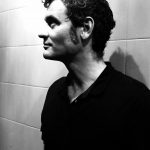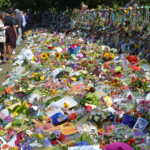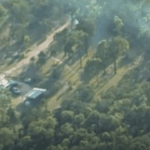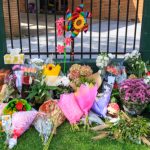Firearm Offences that Apply to Mass Shootings in New South Wales

New South Wales police officers charged Croydon Park man Artemios Mintzas with 25 firearm offences last week, after the 60-year-old conducted a random shooting spree, targeting passersby out the window of a unit located above a shop on Georges Bay Road. The nonlethal incident saw 50 high-powered rifle rounds shot at the public on a street on Wangal land at around 7.45 pm on Sunday, 5 October 2025.
Police were called out to the incident occurring near the intersection with Brighton Street in Croydon Park, with the local area then being locked down by officers attending from Burwood and Inner West Police Area Commands. Over the ensuing two-hour period, NSW police exchanged gun fire with the active shooter, prior to tactical officers storming the residence and apprehending him.
A .30-calibre rifle and ammunition were seized by police. The Sydney Trains employee was refused bail and he went on to appear at Burwood Local Court on 7 October, at which time two separate lawyers both contacted the court outlining that they’d been approached to represent Mintzas, who had no prior criminal record. The man then chose which lawyer he preferred to proceed with.
NSW Ambulance paramedics treated 16 people for minor injuries. A man in his 50s presented at Canterbury Hospital with a gunshot wound, and four other people were hospitalised after initially being seen to at the scene or at nearby Campsie police station.
The news of the Croydon Park shooting was out of the ordinary, however, because mass shootings in NSW, as well as right across Australia, have been a thing of the past, ever since the 1996 Port Arthur mass shooting led the Howard government to rein in gun ownership laws, so that random shooting incidents that had been something of a rising issue, were stamped out.
A long list of firearm offences
After being taken to hospital for treatment of his injuries sustained during the arrest, Mintzas was taken to Burwood police station at 12.30 pm on Monday 6 October, at which point 25 criminal offences were laid against his name, and he’s now being held in prison on remand, or prior to conviction.
Mintzas has been charged with 18 counts of shoot with intent to murder, contrary to section 29 of the Crimes Act 1900 (NSW). This crime carries a 25 year maximum penalty. The prosecution must prove beyond a reasonable doubt that when shooting at individuals, the defendant had intended to kill them.
The offence of shoot with intent to murder also carries a 10 year standard non-parole period. An SNPP is a guidepost or reference point for a sentencing judge, when determining the minimum term an offender must spend behind bars before being eligible to apply for release on parole.
The shooter also had one count of possess loaded firearm to endanger life of another person when not in public, contrary to subsection 93G(1)(a)(ii) of the Crimes Act, which is an offence that carries up to 10 years imprisonment. For the charge to be made out, the firearm, which can include other projectile firing weapons, must contain ammunition.
Mintzas is also being held on remand over one count of discharging a firearm in or near a public place, which is an offence that falls under subsection 93G(1)(b) of the Crimes Act, and it too carries 10 years inside.
One count of possessing an unregistered firearm that is not a pistol or prohibited firearm has also been laid against Mintzas’ name. This unregistered firearm offence sits under subsection 36(1) of the Firearms Act 1996 (NSW) and it carries with it 5 years prison time. But if the offence had involved a pistol or prohibited firearm, the maximum the man would be facing is 14 years.
The shooter is further charged with another count of possess ammunition without holding a licence, permit or any authority, under subsection 65(3) of the Firearms Act,. This offence carries a fine of $5,500.
Mintzas is also up for a count of firing at a dwelling-house with reckless disregard for the safety of others, contrary to subsection 93GA(1) of the Crimes Act. This carries 14 years. A dwelling-house can be a building, vehicle or a vessel someone resides in. Section 93GA contains aggravated versions of this offence, such as when perpetrated during a public disorder, and they carry harsher penalties.
The final count the Croydon Park shooter has been charged with is discharging a firearm with the intent to resist arrest, contrary to subsection 33A(2) of the Crimes Act, which is an offence that carries up to 25 years imprisonment.
The defences related to the crimes
Several defences are available in respect of all of these crimes. Self-defence sits under section 418 of the Crimes Act. It’s a defence that pertains to a defendant having taken action to defend themself or another, or to prevent their own or another’s unlawful detainment or to protect their property or to prevent criminal trespass.
Duress is another common law defence, which involves a threat of death or serious injury being made against the person arguing the defence or their family member and this is said to have caused them to act in the criminal manner in which they did, as there was no other way to avoid the threat, and this holds if it’s found a reasonable person of the same age and sex would act in a similar way.
The third is the common law defence of necessity, which involves an individual being induced to break the law due to circumstances that were bearing down upon them, and this means their actions that involved wrongdoing were perpetrated in order to avoid a much greater peril that awaited if their illegal acts had not been performed.
A thing of the past
Over the 1980s and into the 90s, mass shootings in Australian suburbia were an ongoing, if not a rising, issue. Notable incidents included the 1987 Hoddle Street Massacre in Naarm-Melbourne, the 1991 Strathfield Massacre on Wangal land in the Sydney suburb of the same name, along with the 1984 Milperra Massacre, a shootout between rival bikie gangs, the Comancheros and the Bandidos.
Martin Bryant perpetrated the 1996 Port Arthur Massacre on palawa land at the Tasmanian World Heritage Site that features the ruins of a notorious penal colony. Bryant was able to access a semiautomatic rifle to shoot dead 35 people and injure 23 more. At one point the 28-year-old was able to fire 17 shots, leaving 12 people dead and 10 injured, within the space of 15 seconds.
In the wake of Port Arthur, the newly incumbent Howard government set about establishing the 1996 National Firearms Agreement, which involved sweeping gun reform, and included establishing a licensing system, along with the outlawing of automatic and semiautomatic rifles and pump-action shotguns. An accompanying gun buyback saw 640,000 weapons handed into the state.
The NFA was updated in 2017. The national agreement continues to be the reason that it can be said, the Croydon Park mass shooting is a rare occurrence. However, there are increasing concerns that the guy lobby over time is slowly whittling away at the gun restriction regime.







